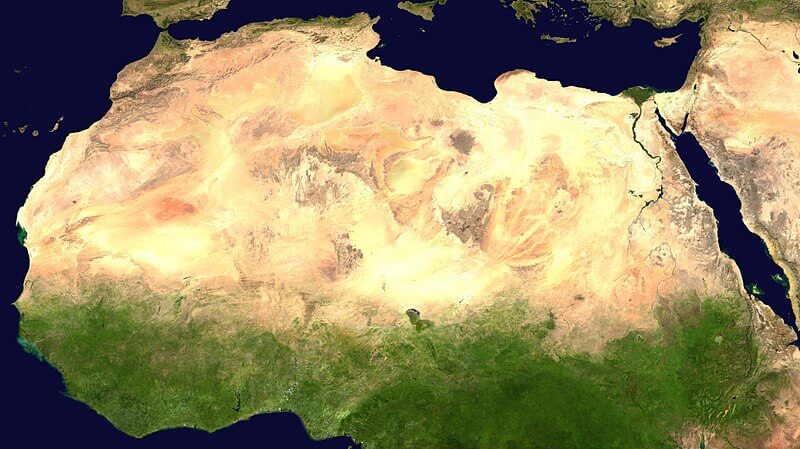Heat shimmers above light-colored dunes, then the sky releases its hold. This is the scenario that some climate models are now outlining for sections of the Sahara, where rainfall has traditionally been infrequent. In a recent study from the University of Illinois Chicago, researchers indicate that summer rainfall in Africa is expected to increase later this century, with the Sahara experiencing the most significant transformations.
The research, published in npj Climate and Atmospheric Science, analyzes a future timeframe of 50 years from 2050 to 2099 on the backdrop of a 1965 to 2014 baseline. Utilizing an ensemble of 40 CMIP6 models and two emissions scenarios—a moderate pathway and a very high one—the team detects continent-wide increases in rainfall with pronounced regional variations. Notably, there is an anticipated 75 percent rise in the Sahara. Southeastern Africa may see an increase of around 24 to 25 percent, South Central Africa approximately 17 percent, while West Southern Africa could edge towards dryness by about 5 percent.
“Altering rainfall patterns will impact billions of individuals, both within and outside Africa,” stated lead author Thierry Ndetatsin Taguela. “We must begin preparations to address these changes, from flood management to the development of drought-resistant crops.”
Mechanistically, the wetter trend primarily stems from thermodynamic processes. Warmer air retains more moisture, setting the stage for heavier rainfall once convection starts. The authors measure this through a moisture budget framework that distinguishes thermodynamic influences—linked to increases in specific humidity due to temperature—from dynamic influences related to circulation. In numerous regions, the vertical thermodynamic element outweighs the increase in rainfall. The Sahara’s narrative introduces complexity, with horizontal dynamic shifts and evaporation playing a role as well.
The drying trend in West Southern Africa illustrates a different mechanism. Here, models anticipate a weakening of the ascending limb of the Hadley circulation during the austral summer. This dynamic alteration curtails convection even as near-surface temperatures rise, neutralizing the moisture uplift and shifting the balance towards reduced rainfall.
## Consensus Among Models, And Areas of Disagreement
Consensus on the direction of change is strong in many areas. At least 70 percent of models align on the ensemble mean changes across critical grids. However, the magnitude remains uncertain. The authors categorize uncertainty into three sources: model, scenario, and internal variability. Model uncertainty prevails throughout Africa and expands with lead time, constituting over 85 percent of total variance by the century’s end. The familiar challenges for tropical meteorologists include subgrid parameterizations for deep and shallow convection, cloud microphysics, and boundary layer turbulence. Scenario discrepancies become more significant late in the century for certain regions. Internal variability diminishes over time and is minor by comparison.
A subtle finding caught my attention. The mechanisms driving the average increase differ from those responsible for model discrepancies. Vertical thermodynamics elevate the average moisture; however, the variations between models correlate more closely with vertical dynamics, specifically how circulation changes are modeled. Simply put, models can agree on a wetter future as likely while differing on the extent, because they diverge in their representation of vertical motion and convective organization in response to warming.
“The Sahara is predicted to nearly double its historical precipitation amounts, which is striking for such a climatologically arid region,” Taguela remarked.
For planners, this signal brings both possibilities and threats. Increased water could replenish aquifers and foster greener seasonal pastures, but it also heightens the risk of flash flooding, damage to infrastructure, and outbreaks of disease. The paper highlights late summer intensification in various regions, an important timing factor for agriculture and reservoir management. It also emphasizes that convective precipitation will continue to represent the majority of totals across most of Africa, indicating that short-duration, high-intensity events will be crucial for adaptation strategies.
## Considerations for Adaptation and Future Actions
Clear opportunities for action are evident. Invest in sub-daily observation networks that effectively capture convective storms. Adjust flood models to account for short, intense rainfall rather than relying solely on monthly averages. Rigorously test food systems against both wetter and drier scenarios, particularly in West Southern Africa where drying is anticipated. Enhance efforts to refine convection and cloud microphysics in global models, as these parameters influence most of the uncertainty and consequently most of the associated risks.
The authors also associate some of the variability with global mean surface warming and equilibrium climate sensitivity. Models exhibiting higher sensitivity generally amplify the thermodynamic moisture response. While this does not resolve the spread issue, it clarifies some aspects and reveals a broader principle. Improved constraints on climate sensitivity and a better depiction of tropical convection will yield benefits for African hydroclimate projections.
The main takeaway remains striking. A desert characterized by scarcity could witness more frequent summer rains by the century’s end, alongside significant increases across much of the continent. The water cycle is accelerating. The challenge ahead is to communicate this urgency to engineers, farmers, and city managers before the clouds gather.
[npj Climate and Atmospheric Science: 10.1038/s41612-
